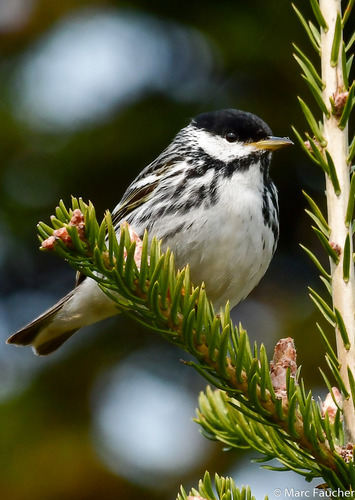
Blackpoll Warbler
The Blackpoll Warbler (Setophaga striata) is a small New World warbler known for its remarkable long-distance migration. Despite its diminutive size, this bird undertakes one of the longest overwater migrations of any North American songbird, flying nonstop for several days over the Atlantic Ocean. Ecologically, it plays a role in insect control in both its breeding and wintering grounds. While not holding significant cultural significance compared to some other bird species, its incredible migration feat has made it a subject of intense scientific study and a symbol of endurance for bird enthusiasts.
12.5-15 cm
Length
20-23 cm
Wingspan
Least Concern
Conservation Status
Distribution
Breeds across northern North America, from Alaska to Newfoundland, south to the northern United States. Migrates to wintering grounds in northern South America, east of the Andes, and across the Caribbean. The autumn migration involves a significant overwater flight across the Atlantic.
Lifespan
Average lifespan in the wild is likely 2-3 years, although some individuals may live longer.
Blackpoll Warbler's Habitat
Habitat Types
Boreal forests, Coniferous forests, Mixed woodlands (during migration), Tropical forests (wintering grounds)
Climate Zones
Boreal, Temperate (breeding), Tropical (wintering)
Adaptations
Accumulates significant fat reserves prior to migration to fuel the long overwater flight. Navigational abilities are highly developed, likely using a combination of celestial cues, magnetic fields, and possibly infrasound.
Variations
No widely recognized subspecies, although some slight variations in plumage and size have been noted across its range.
Appearance
Breeding Plumage
Breeding males have a black cap, white cheeks, and black streaks on a white underside. Females and non-breeding males are duller, with a grayish or olive-brown cap and less distinct streaking.
Seasonal Feather Changes
Significant seasonal variation. Breeding plumage is acquired in spring and lost in late summer after breeding.
Sex Based Plumage Differences
Yes, breeding males are distinctly more patterned than females.
Notable Features
Black cap (breeding males), White cheek patches (breeding males), Streaked back, Two white wing bars
Diet and Feeding
Primary Foods
Insects, Spiders, Berries (especially during migration and winter)
Foraging Behavior
Actively gleans insects from foliage in trees and shrubs. Will also hover briefly to catch insects in mid-air.
Specializations
No highly specialized feeding adaptations, but its slender bill is well-suited for picking insects from leaves.
Seasonal Diet Variations
Diet shifts to include more berries during migration and on the wintering grounds when insects are less abundant.
Behavior
Social Structure
Generally solitary or in pairs during the breeding season. May form loose flocks during migration.
Communication
High-pitched, thin 'tsit' calls, A complex song consisting of a series of high-pitched notes
Migration
One of the longest migrations of any North American songbird. Flies nonstop for up to 88 hours over the Atlantic Ocean, covering distances of up to 2,500 miles.
Territorial or Group Behaviors
Males are territorial during the breeding season, defending their nesting area from other males.
Conservation
Threats
Habitat loss (both breeding and wintering grounds), Climate change (potential impacts on migration timing and food availability), Collisions with buildings and other structures during migration
Protection Programs
Migratory Bird Treaty Act (in the US), Various habitat conservation initiatives in breeding and wintering areas
Local National Laws
Protected under various national and international laws related to migratory birds.
Population Trend
Stable
Population Estimates
Global population estimated to be around 40 million individuals.
Interesting Facts
Blackpoll Warblers nearly double their body weight before migration.
This extra fat provides the energy needed for their long, nonstop flight over the ocean.
They navigate using a combination of the Earth's magnetic field, stars, and polarized light.
This allows them to maintain their course even over vast stretches of open water.
Their migration route is influenced by prevailing winds.
They take advantage of tailwinds to aid their journey.
Faqs about Blackpoll Warbler
How can they fly for so long without stopping?
They build up massive fat reserves before migrating, providing the necessary fuel. They also utilize efficient flight strategies and may enter a state of torpor to conserve energy.
Where can I see a Blackpoll Warbler?
During the breeding season, look for them in boreal and coniferous forests across northern North America. During migration, they can be seen in a wider variety of habitats, including forests, parks, and gardens.
Are Blackpoll Warblers endangered?
No, they are currently listed as Least Concern by the IUCN. However, like many migratory birds, they face threats from habitat loss and climate change.
Copyright @ Nature Style Limited. All Rights Reserved.
 English
English